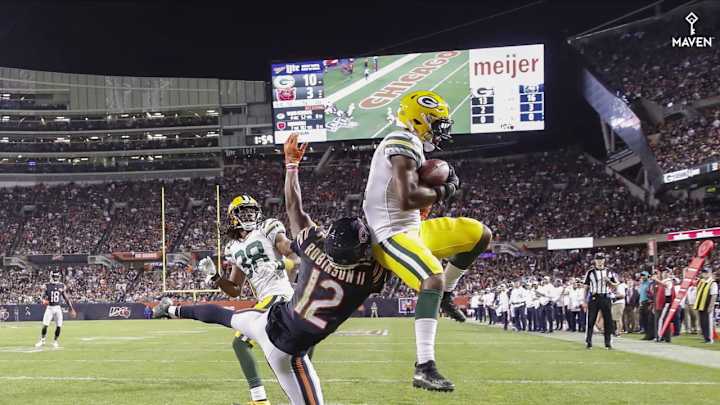How Packers Taking Adrian Amos Really Affected Bears

Watching the Green Bay Packers play for the right to go to the Super Bowl is difficult enough for Chicago Bears fans.
Watching them do it with their old safety playing a big part in their rivals' defense has to be downright gut-wrenching. Maybe it's not like seeing your ex finding happiness with some other guy or girl but it is pretty revolting.
Of course, the Bears didn't need to go long into this season to see how tough this kind of a situation can be. Mitchell Trubisky's forced, senseless throw from the 16-yard line with the game hanging in a balance, the one that ended up in Adrian Amos' arms instead of Allen Robinson's, did it.
One of the most intriguing switches of all time in the NFL was Amos going to play for the Packers while facing the Bears in the opener, with the Bears bringing in ex-Packer Ha Ha Clinton-Dix in his spot.
It came about because the Bears couldn't see preserving their defense's salary integrity with two high-priced safeties long term, and short term they were right up against the salary cap.
After the signing of Clinton-Dix, Bears director of player personnel Josh Lucas compounded the situation at last summer's 100th anniversary Bears celebration with his famous quote about the two safeties.
"We're not just saying this right now because he's (Clinton-Dix) here and Amos in Green Bay," Lucas said. "We have consistently graded Ha Ha as a better player than Amos for four years. We played against him twice a year."
Stats Galore
The statistical breakdown is murky but the bottom line is always the cash. And while the Bears could have afforded to keep Amos at the cap cost for 2019 that the Packers absorbed, they probably couldn't have afforded also bringing in Buster Skrine as Bryce Callahan's replacement. That is a move debatable in its merit and also a discussion for another day.
If the Bears had kept Amos at what the Packers gave him, it wasn't the $5.9 million against the 2019 cap where they'd have struggled. It's the $9.4 million, $10.05 million and $10.6 million the next three seasons they couldn't have done if they wanted to give Eddie Jackson a $58.4 million deal.
Jackson earned a second straight Pro Bowl appearance this year.
Two highly paid safeties is not something all teams can afford.
On the field, the Packers definitely got their use out of Amos. His two interceptions matched what he did in 2018 for Chicago. His eight passes defensed was one less than with the Bears. He had eight more tackles (81) than in his best Bears season (2018).
Clinton-Dix had the same number of interceptions Amos had this year and last year (2).
According to Sportradar, the NFL's official stat partner, Clinton-Dix enjoyed a slightly better year as a pass defender than Amos.
Amos allowed 11.7 yards a completion, gave up one touchdown pass, allowed an 85.5 passer rating when targeted and gave up 148 yards after the catch. He allowed 70.6% completions when targeted.
Clinton-Dix allowed only a 67.0 passer rating when targeted, gave up 11 yards a completion to go with one touchdown and allowed only 96 yards after the catch. Teams completed only 59.1% when targeting him.
The Bears couldn't complain about Clinton-Dix. The biggest problem they have with him is he was only a one-year fix. The deal they gave him was $3.25 million for one year, a prove-it deal.
He proved it. So now what?
They either pay Clinton-Dix or the entire Amos signing ultimately does come back to burn them in 2020.
The Hit Man
There was one negative effect on the Bears with losing Amos. It was easily predictable and one actually forecasted here last offseason.
Amos is and always has been an excellent fundamental tackler. He closes rapidly and wraps up. He was the best tackler in the secondary for the Bears and it allowed others to gamble at times because he could clean it up.
This year in Green Bay, Amos missed on 5.8% of his tackle attempts. Clinton-Dix missed on 10.3% of his with the Bears.
In fairness to Clinton-Dix, Amos was much better at this with the Packers even than he was with the Bears. Last year in Chicago he had a 9.9% missed tackle rate, barely ahead of Clinton-Dix's rate this year.
Bringing a "disinterested" party into it, Pro Football Focus gave Amos a 76.4 grade this year and Clinton-Dix a 74.2 in 2019.
Any Bears follower will tell you PFF is traditionally biased toward the Packers and against the Bears, and this is verifiable. So the slight difference in grade can be counted as a wash.
What can best be said in generality is Amos was one part of the Packers' grand plan to secure their terrible secondary, and it worked. It's part of the reason they're in the NFC title game. And Clinton-Dix did an excellent job at keeping the Bears from missing Amos, while in many ways outplaying him.
The Packers finished third in completion percentage allowed after being 12th last year. They were sixth in passer rating allowed. The Bears did decline in team completion percentage allowed and passer rating, although maintaining their passer rating would have been super human because they were at an other-worldly 72.9.
The Real Problem
The decline in Chicago's team defense this year had little to do with Clinton-Dix or Amos. It had more to do with injuries and the constant pressure the Bears faced defensively because of their own offense's inept performance.
Playing from behind all the time shackles a defense. It resulted in 18 fewer sacks, 17 fewer interceptions, a drop from tops in scoring defense to fourth, and fall from third in yards allowed to eighth.
All the Pro Bowl safeties in the world won't correct this problem because you can't attack on defense when you're on your heels.
Twitter@BearsOnMaven
